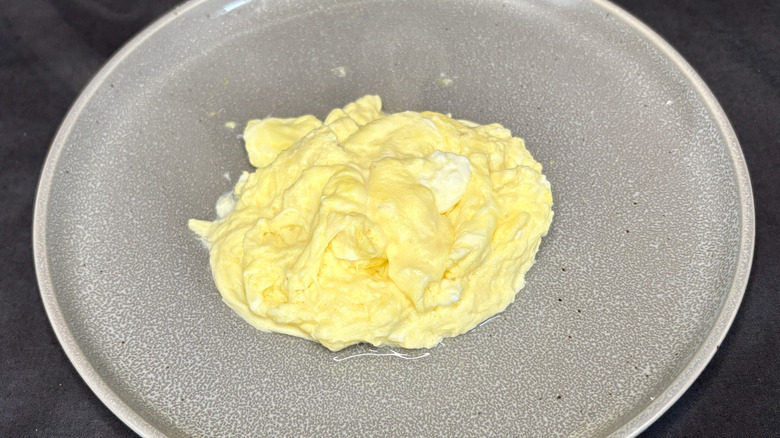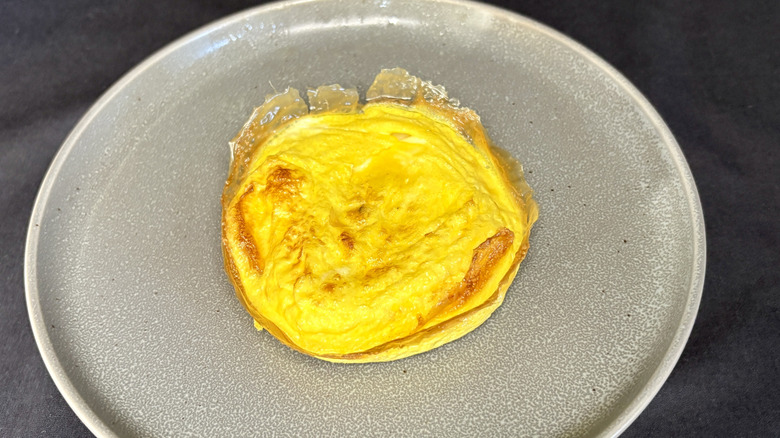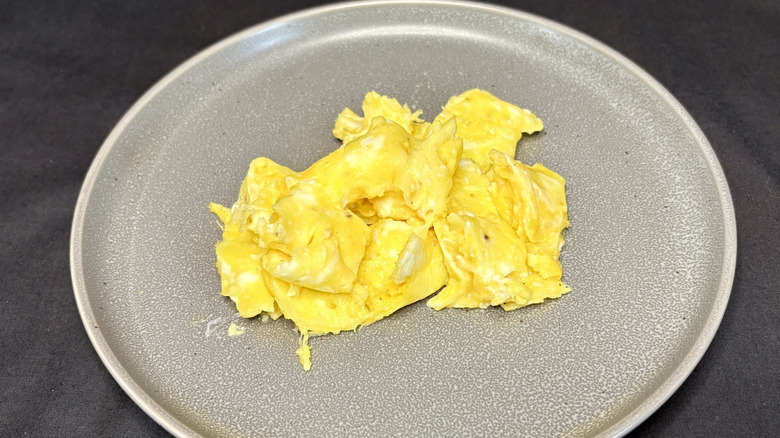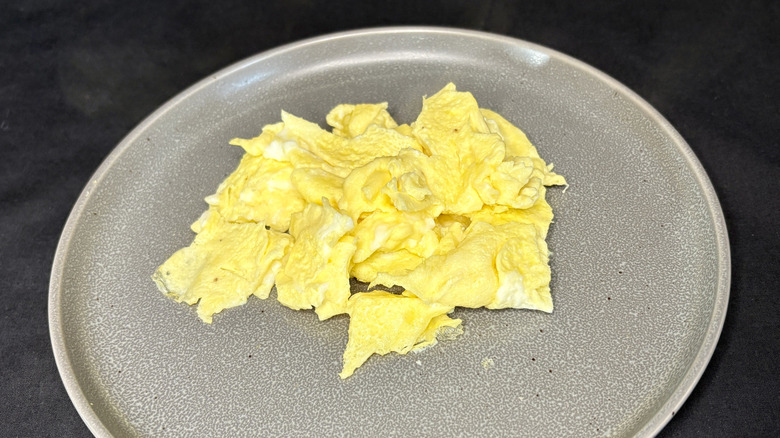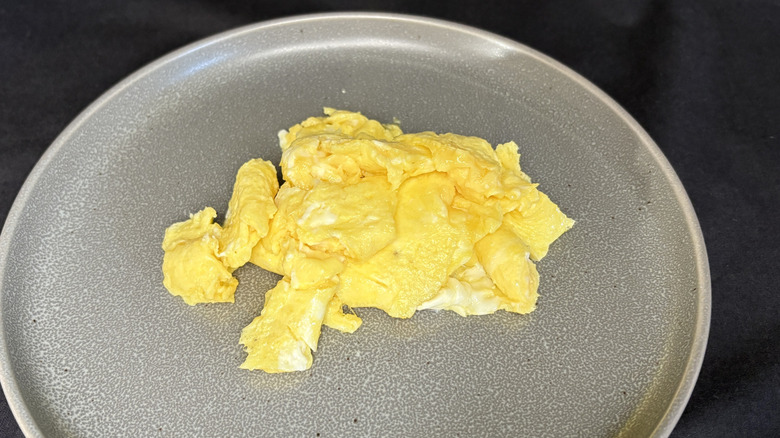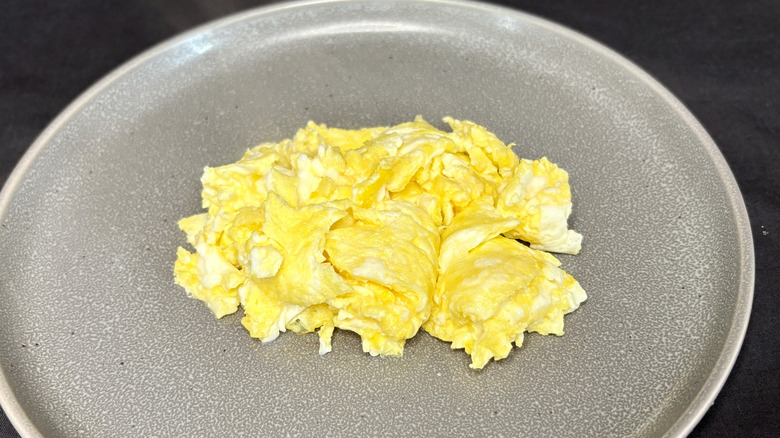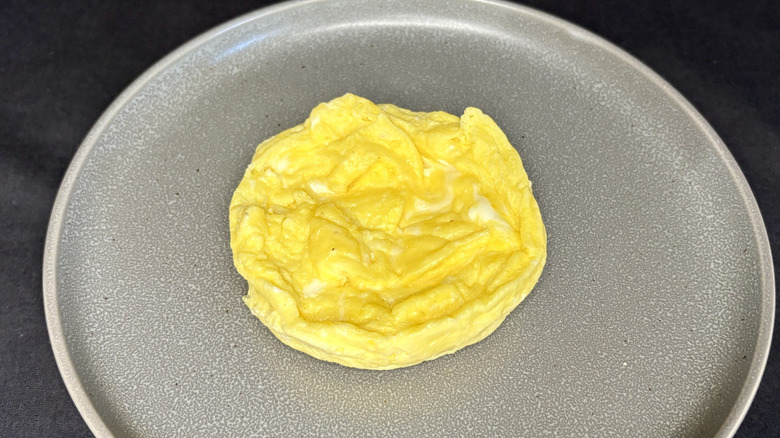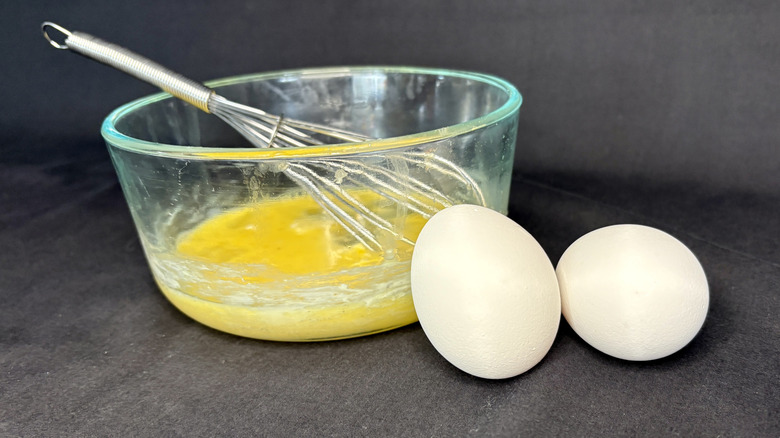We Tried 12 Different Ways To Cook Scrambled Eggs. Here's How They Ranked
There are countless ways to cook an egg. I like a fried egg over easy for a sandwich, poached if there's hollandaise sauce, and deviled if I'm at a party and in the mood to eat five whole eggs before dinner. Among all of those options, though, few methods are quite as classic as the scrambled egg. For most folks, it's the first style of egg we ever consume, and for many, it's the go-to when preparing breakfast in the morning.
Of course, something so simple can still be full of intricacies, and the scrambled egg is no exception. One of my best friends made them in college by cracking eggs into a non-stick pan and violently whisking them with a metal fork. I do not recommend that particular method, but there are a ton of viable ways to make a good scrambled egg. I set out to try a handful in search of the best possible option, and ranked each method from worst to best below (for a full explanation of my methodology, check out the end of this piece). Some were successful, others were not — but as is true in any investigation, to get to the truth, sometimes you have to break a few eggs.
12. Cooked in boiling water
Who is this for? What am I supposed to do with all of this water on my plate? Those were the questions I asked after cooking two scrambled eggs in boiling water. Listen, I like a good poached egg, and egg drop soup is tasty, but this is just the most unnecessary cooking process I've ever seen.
As with all of the other experiments on this list, I used two large eggs, which I beat in a bowl with salt and pepper. I opted not to add any additional liquid to the mixture because, well, it was all going in a pot of boiling water, right? Following the advice of a few recipes, I stirred the water in a circular motion so it all moved in the same direction. From there, I poured the mixture in and watched the eggs swirl and cook almost instantly. It was beautiful in an abstract way, and the visual was easily the best part about this cooking method.
After fishing out the eggs with a slotted spoon, I let as much water as I could drip back into the pot — super appetizing — and then plated my mass of soggy eggs. From a taste perspective, these were bland. A few pepper flakes managed to hang on in the cyclone, but the salt completely dissolved in the water. In the end, scrambled eggs boiled in water are edible, but wet and entirely unnecessary.
11. Cooked in the airfryer
I love my air fryer. It's a fantastic option for roasting vegetables, and a godsend for leftover pizza. Still, that doesn't mean it's the ideal appliance for everything, as evidenced by my air-fryer scrambled eggs. I tossed two eggs — once again mixed with a splash of milk, salt, and pepper — into a buttered Pyrex dish, which was actually where I ran into my first issue: finding an oven-safe vessel small enough for my air fryer but big enough to hold two eggs. I know everyone has a different style and size device, but I don't run into that problem with my microwave or conventional oven, so that's already a strike against the air fryer.
I loosely followed a few online recipes and set the temperature to 370 degrees Fahrenheit. After three minutes, I checked the contents to find a hard shell had formed over the top of a lake of molten egg. I gave the eggs a gentle stir, returned them to the fryer, and repeated the process every three to five minutes for the next 15 minutes. Honestly, that's too much time to devote to scrambled eggs. In the end, I was faced with a chewy egg patty with a dry top. I promise I only cooked it until the eggs set, and still, it was overcooked. Hard pass on the air fryer method.
10. Cooked in the microwave
We move from the most time-consuming method to the quickest. Generally, I wouldn't eat plain scrambled eggs. There are too many fun things you can add to eggs, and, as a Wisconsinite, there's always cheese, so I prefer my eggs dressed up. In the case of microwaved scrambled eggs, dressed up is definitely the way to go.
For this cook, I added a splash of milk to my mix and made sure the microwave-safe bowl I chose was buttered to prevent sticking. The two eggs cooked in just over a minute, and the result was an egg patty that easily flopped out of the buttered dish. The flavor was fine — nothing special — but it's the texture that lands this method so low on the list. The eggs were flat and rather chewy. I may have ended up with fluffier eggs had I cooked them in segments and stirred as I went, but with a single minute from start to finish, I wanted to see what results an uninterrupted process bore. The answer is an egg patty that would benefit greatly from vegetables, perhaps some meat, and definitely cheese.
9. Cooked in a hot pan
If the microwave is the speediest of options, cooking eggs in a hot pan is close behind. For this one, I mixed my eggs as usual and added 2 tablespoons of butter to a hot pan. The butter took only a minute to melt, and once it was sizzling, I poured in the eggs. If you're going to try this method yourself, be prepared because things move fast. I began stirring the eggs almost immediately and never stopped. In total, it took maybe two minutes, so there's no denying the efficiency, but that's about all this method has going for it.
The result was small curds and a total lack of fluff thanks to the constant stirring. Each bite was on the rubbery side, and while the taste was fine, the smell was unavoidable. Seriously, if anyone in your house doesn't like the smell of eggs, don't subject them to this cooking method. It was far more potent than any of the rest, and for that reason alone, if not for the general lack of texture, this method is not a winner.
8. Mixed with cornstarch slurry
Of the eight entries on this list, half used a unique cooking method, and the other half tweaked the ingredients added to the eggs. Generally, I use milk and a buttered pan to make eggs (a tried-and-true method that will show up later), but there are plenty of debates about what liquid to add to achieve the optimal texture for scrambled eggs. One that piqued my curiosity was a cornstarch slurry.
I fully dissolved 1 teaspoon of cornstarch in 2 ¼ teaspoons of milk, then incorporated the eggs and seasoning. In a medium-hot pan with butter, I slowly cooked the eggs, folding them as they cooked, keeping an eye out for over-stirring. Compared to some of the thinner egg mixtures, this one reminded me of a crepe batter. As they cooked, the eggs took on a fluffy and very smooth texture. In the end, they came out cakey. The flavor wasn't overly eggy, as I think the cornstarch mellowed everything out to a degree.
This was hardly a labor-intensive process, but I'm still not sure the juice is worth the squeeze. I might be curious to try this method if I'm making an omelette, as the extra-fluffy eggs would be fun in that dish, but for a simple serving of scrambled eggs, this feels like a bit much.
7. Mixed with water
The water-vs-milk debate might be the most hotly contested in the world of scrambled eggs. The theory behind turning to water instead of milk is that the water will evaporate during the cooking process, leaving the eggs light and fluffy, whereas milk tends to stick around and result in denser eggs. Personally, I think that's all a reach. A tablespoon of water in the eggs didn't do anything remarkable, like giving me the fluffiest or most tender eggs ever. If anything, it gave me a very pale plate of eggs that tasted especially eggy.
To each their own, but I don't get the hype. If you don't have milk or cream, water is fine, but there's no way to convince me it's the superior option for scrambling eggs. Next time, maybe I'll try adding club soda because, in my experience, water in scrambled eggs is nothing but an overblown trend.
6. Cooked in the oven
This is the grown-up version of the microwave method. Once again, my two eggs were joined by salt, pepper, and a splash of milk in a buttered baking dish. (I used a soup crock because it was the perfect size.) I checked out a variety of recipes online and found that the most common cooking temperature was 350 degrees Fahrenheit, with cooking times in the 10-15-minute range. Imagine my surprise when it took 25 minutes for my eggs to set.
Long wait aside — and I'm willing to attribute that to my choice in baking vessel as much as anything else — the final product was quite pleasant. Whereas the microwaved egg patty was dense, the one from the oven fluffed up nicely. I'm still not sure this is "scrambled eggs" in the sense that you can enjoy a spoonful of curds, but more of a light, fluffy egg patty that I would happily put on a breakfast sandwich. This is hardly an everyday method for cooking scrambled eggs, but in the right setting, eggs in the oven work out well.
5. Cooked in a cold pan
Generally speaking, cooking scrambled eggs should be pretty simple. Some methods are more time-consuming than others, but even the longest pale in comparison to preparing a more complex meal. Cooking eggs in a hot pan appeared earlier on the list with rather poor results. This is the prequel to that effort: the cold pan.
If you enjoy watching a pot of water as it boils, this method is for you. I poured the egg mixture into a cold pan and added a few thin slices of cold butter. Over medium-low heat, the butter slowly melted, and the eggs eventually began to solidify. This method is the ultimate low-and-slow cook, so I was able to gently fold the eggs over and over to create a light, airy pile of large curds. The butter, more than I would generally use (but not by much), comes through in every bite, making this one of the more flavorful options. If you're not in a rush or don't love the stress of a quick cook, making scrambled eggs in a cold pan is a solid choice.
4. Whisked in the pan
Sometimes you just need to move in the morning, so pulling out an extra bowl to whisk your eggs is simply too much. Fear not; you can make perfectly satisfactory eggs straight in the pan with a pad of butter and a touch of seasoning.
One recipe I consulted compared these scrambled eggs to those you might find on the breakfast sandwiches at a New York City deli. The color isn't uniform, but instead a marbled white and yellow, as the two halves of the egg never fully mix. I used a rubber spatula in a non-stick pan to avoid adding any Teflon flakes to my scramble.
The result was a simple but effective batch of scrambled eggs. The curds were a bit smaller than others, thanks to the additional stirring over heat, and they weren't quite as fluffy due to the lack of extra liquid. Next time, I would incorporate some butter to add a little more body to these eggs, but the flavor was good. In terms of simplicity, this is as easy as scrambling an egg can get.
3. Mixed with milk
Listen, if you can't consume dairy or are simply out of milk, using water in your eggs is fine to fluff them up. If you have access to milk, though, please, don't overthink it. There's a reason your first instinct is probably to add a splash of milk to your eggs: it tastes good and it works.
I used a tablespoon for two eggs, and I was surprised by the difference between these and the eggs made with water. Visually, the milked eggs had a much brighter, more appetizing golden color than the washed-out watered eggs. The flavor was also noticeably better. I used 2% milk, so it's not as if I used heavy cream to add a significant punch of fat, but the flavor was still fuller and more well-rounded than with water.
If it's not broke, don't fix it. Milk belongs in scrambled eggs, and I would recommend it as the standard process every time. Of course, I set out to find the best overall method, and number one is hard to beat.
2. Mixed with mayonnaise
As anyone who's ever visited the DMV will attest, redundancies are simply an unavoidable part of life. Thankfully, not all are quite as tedious and unnecessary as government agencies make them, which is why adding mayonnaise — famously made with eggs — to scrambled eggs is not only easy, but also delicious.
I added a heaping spoonful of mayo to my two eggs and mixed. It took a little longer to incorporate the mayonnaise evenly into the egg mixture, but the extra 30 seconds of stirring was well worth the effort. Most mayo-centric egg recipes call for a zap in the microwave, so that's what I did. After 30 seconds of cook time, I gently folded the cooked outer layer into the center, then repeated the process a few more times until the eggs were set.
Not only did the mayo result in significantly fluffier eggs than the standard microwave mixture, but they were also more flavorful. The rich flavor of the mayo works extremely well in scrambled eggs, so much so that I'm definitely trying this again with a few flavored mayos, to see if I can create a gourmet egg option in the microwave.
1. Mixed with cottage cheese
It's really no surprise that the one scramble with cheese made it to the top. Cottage cheese is absolutely the "it" food in the world of high-protein TikTok recipes. From pasta sauces to a cream cheese replacement, the internet simply can't get enough cottage cheese. Ironically, neither can my toddler, which is why I needed to try making scrambled eggs with the stuff. I used ¼ cup for this experiment, and while I could have added more, I liked the results. Mixing in the cottage cheese did require a gentler touch to avoid pulverizing the curds, so I recommend whisking your eggs as normal, then gently folding in the cottage cheese before cooking.
Ultimately, these turned out to be the eggs with the most flavor. Yes, they're on the denser side, but that's hardly a surprise given the inclusion. Depending on the fat content of your cottage cheese, you may find a bit of excess moisture in the pan after cooking, but it's nothing compared to the sopping-wet mess from the boiling-water method, and it's easy to avoid when removing the eggs from the pan.
The flavor is great, the texture is good, and the added protein is undeniable. For anyone who doesn't love cottage cheese, I still encourage giving this method a shot at least once. I don't think the flavor or texture shines past the egg. Instead, it elevates the whole dish into a scrambled egg worthy of eating solo and making again.
Final thoughts and methodology
Scrambled eggs are one of the simplest foods that even the most kitchen-inept can make and enjoy, but they're also full of possibilities. As much as I enjoyed experimenting with different cooking methods and ingredients, I found that simple tends to be better and anything involving cheese tends to be best. I encourage you to play around with your egg routine, because there's a good chance my favorite will be different from yours. Just know that the standard I've set is 16 scrambled eggs without a single scrap of shell finding its way into the pan. (Trust me, no one was more surprised by the lack of crunch in my eggs than I was.)
I used two eggs, salt, and pepper in all egg dishes to create as consistent a flavor as possible. I tried each method one at a time, taking photos immediately after cooking and then tasting. My evaluations were based on taste, texture, appearance, and the method's functionality.

